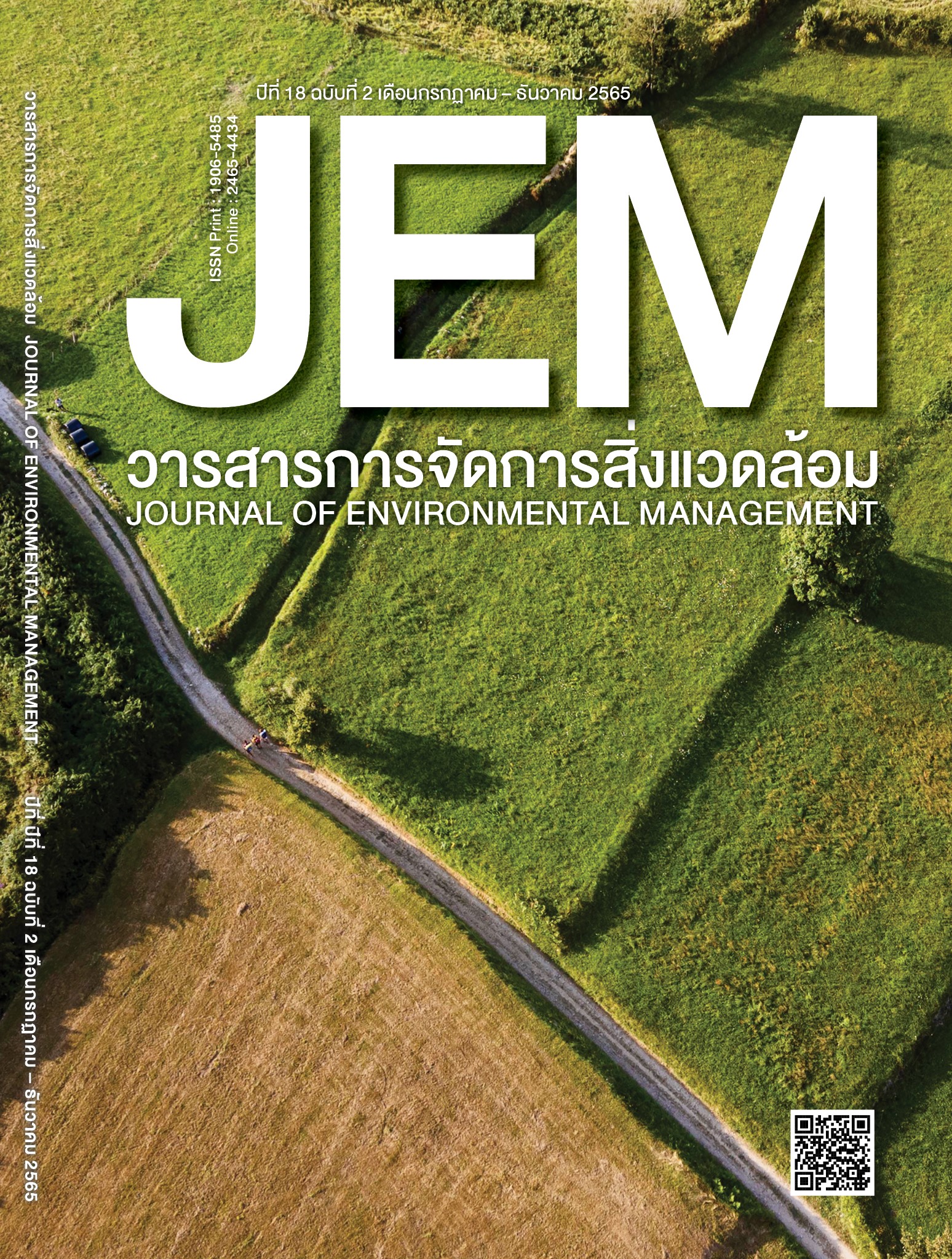ลักษณะการกัดเซาะชายฝั่งหน้าผา และแนวทางการจัดการ: กรณีศึกษา บ้านฝั่งแดงจังหวัดประจวบคีรีขันธ์
DOI:
https://doi.org/10.14456/jem.2022.9คำสำคัญ:
การกัดเซาะชายฝั่งหน้าผา, การจัดการชายฝั่ง, การเปลี่ยนแปลงชายฝั่งบทคัดย่อ
พื้นที่ศึกษาบริเวณบ้านฝั่งแดงจังหวัดประจวบคีรีขันธ์มีลักษณะเป็นชายฝั่งหน้าผาของชั้นหินทรายสลับกับชั้นกรวดมน พบร่องรอยของการกัดเซาะที่เกิดจากกระบวนการชายฝั่งเป็นจำนวนมาก จากปัญหาที่เกิดขึ้นนี้ทำให้ผู้วิจัยต้องการศึกษารูปแบบการกัดเซาะที่เกิดขึ้นเพื่อหาความสัมพันธ์ของการกัดเซาะกับลักษณะวิทยาหิน (lithology) โครงสร้างทางธรณี (Structure) และลักษณะของการเปลี่ยนแปลงของชายฝั่ง เพื่อให้เข้าใจถึงปัญหา และเสนอแนวทางจัดการปัญหาที่เกิดขึ้น จากการศึกษาทางธรณีวิทยาและวิเคราะห์การเปลี่ยนแปลงชายฝั่งด้วยการวิเคราะห์ทางภูมิสารสนเทศ โดยใช้ข้อมูลภาพถ่ายทางอากาศในช่วงปี พ.ศ.2509 - 2560 พร้อมทั้งสัมภาษณ์เชิงลึกกับผู้ให้ข้อมูลสำคัญ โดยพบว่าปัจจัยที่มีผลอย่างมากต่อการกัดเซาะคือโครงสร้างทางธรณีวิทยาที่ประกอบไปด้วย รอยแตก ระบบรอยแตก และ รอยเลื่อนตามแนวระดับ (Strike – Slip Fault) ซึ่งทำให้เกิดลักษณะโครงสร้างไม่ต่อเนื่องในเนื้อหิน นอกจากนี้การตั้งถิ่นที่อยู่อาศัยของชุมชนส่งผลให้น้ำที่เกิดจากการอุปโภคในครัวเรือนและการเกษตร และมีผลกระทบต่อค่าความทนทานในเนื้อหิน เพื่อให้เกิดการจัดการชายฝั่งหน้าผาอย่างยั่งยืน ผู้วิจัยจึงได้เสนอแนวทางการจัดการที่ครอบคลุมทั้ง 3 มิติได้แก่ มิติสิ่งแวดล้อมเพื่อป้องกันผลกระทบ และมิติสังคมกับสิทธิมนุษยชนในพื้นที่ในการรับทราบข้อมูล และมีส่วนร่วม รวมถึงการสร้างรายได้ในมิติเศรษฐกิจ
เอกสารอ้างอิง
Canter, L. (2000). Cumulative Effects Assessment. Training Course on Cumulative Effects Assessment August 7-11, 2000. Office of Environmental Policy and Planning, Bangkok.
Choowong, M., et al. (2014). Surveying and making a sustainable community management plan for unknown geologic tourist along the Thai coastline for development into an international tourist destination (progress report) [In Thai]. Progress Report, National Research Council of Thailand Bangkok, Thailand.
Cooper, J.A.G. & McKenna, J. (2008). Social justice in coastal erosion management: The temporal and spatial dimensions. Geoforum, 39, 294–306.
Fossen, H. (2010). Structural geology. New York: Cambridge University Press.
Jarupongsakul, S. (2005). Prioritization of importance and severity area and appropriate resolutions of coastal erosion problems at Pak Phanang river basin, Nakhon Si Thammarat Province [In Thai]. Journal of Metal, Materials and Mineral, 15(1), 11–25.
Korure, T., Aoki, H., Maekado, A., Hirose, T., Matsukura, Y. (2006). Effect of the development of notches and tension cracks on instability of limestone coastal cliffs in the Ryukyus, Japan, University of Tsukuba, Ibaraki.
Gioacchino, F., Andriani, N. ( 2007). Rocky coast geomorphology and erosional processes: A case study along the Murgia coastline South of Bari. Apulia — SE Italy , Italy , Dipartimento di Geologia e Geofisica, Università degli Studi di Bari, Via Orabona.
Leeladee, P. (2012). The study of erosion problem on coastal local community: a case study of Bang Khun Thien coastal communities, T. Thakham, A. Bang Khun Thien, Bangkok [In Thai]. Published Master’s thesis, Silpakorn Unversity.
Pechchan, P. (2010). Land Use Change of Coastal Area in Ban Nai-Thung and Ban Sa-Bua, Tha Sala District, Nakhon Si Thamarat Province [In Thai]. Research Report, School of Engineering and Resources, Walailak University.
Phaksopa, J. (2006). Studying Erosion coastal problem and human right coastal of Chonburi Rayong and Tart Province [In Thai]. Final Report, Office of the National Human Right Commission of Thailand, Thailand.
Phoochinda, W. (2017). Research Methodology and Statistics in Environment and Energy [in Thai]. (4th ed.). Bangkok: Environmental School.
Poboon, C. (2017). Environmental Assessment [in Thai]. Bangkok: All in one printing Bangkok.
Rattanarat, J., Saetang, P. (2017). The Opinions of Community about the Problem of Coastal Erosion, Thailand [In Thai]. Thai Science and Technology Journal, 5, 723 – 732.
Sinsakul, S., Tiyapirus, S., Chaimanee, N. & Aramprayun B. (2001). Shoreline Changes in the Gulf of Thailand [In Thai]. Final Report, Department of Mineral Resources, Ministry of Natural Resources and Environment, Bangkok, Thailand.
Sunamura, T. (1992). Geomorphology of rocky coast. Institute of Geoscience. University of Tsukuba, Ibaraki 305, japan.
Takamol, S., Phantuwongraj, S. (2017). Erosion of cliffed coast at Ban Fang Daeng,Changwat Prachuap Khiri khan [In Thai]. A report submitted in partial fulfillment the requirement for degree of Bachelor Of Science Department of geology, Chulalongkorn University.
Wellman, H., Wilson, A. (1965). Salt Weathering, a Neglected Geological Erosive Agent in Coastal and Arid Environments. Nature, 205, 1097–1098.



